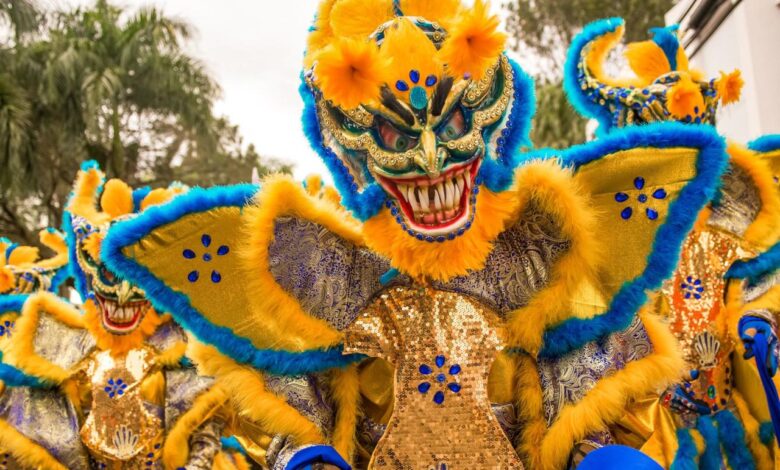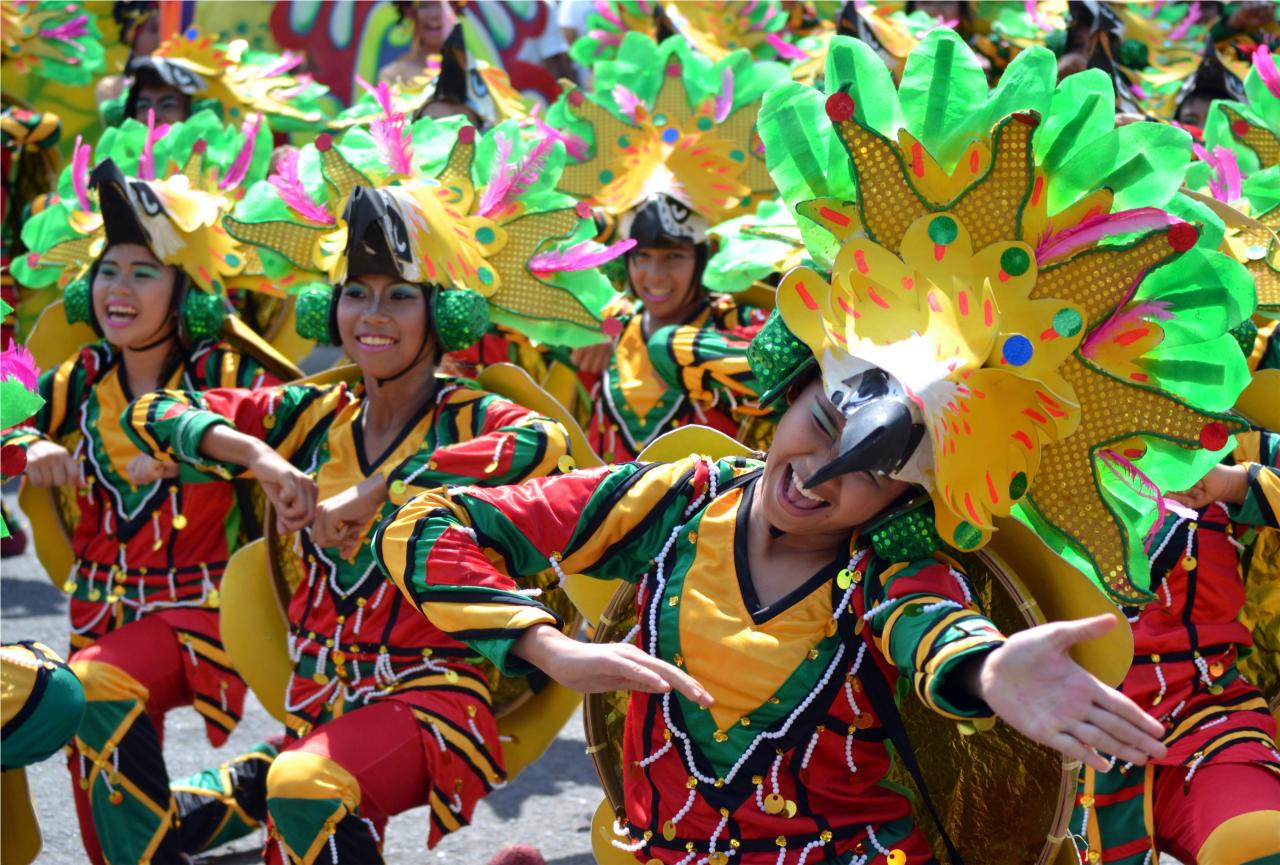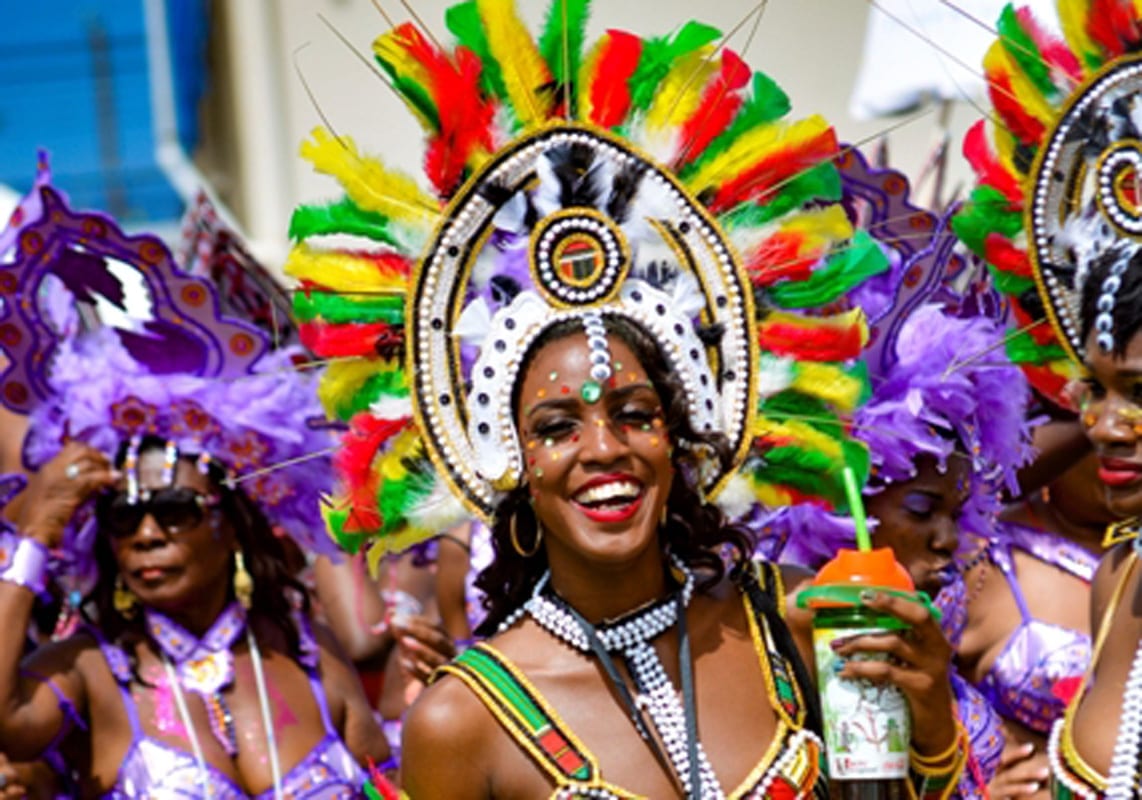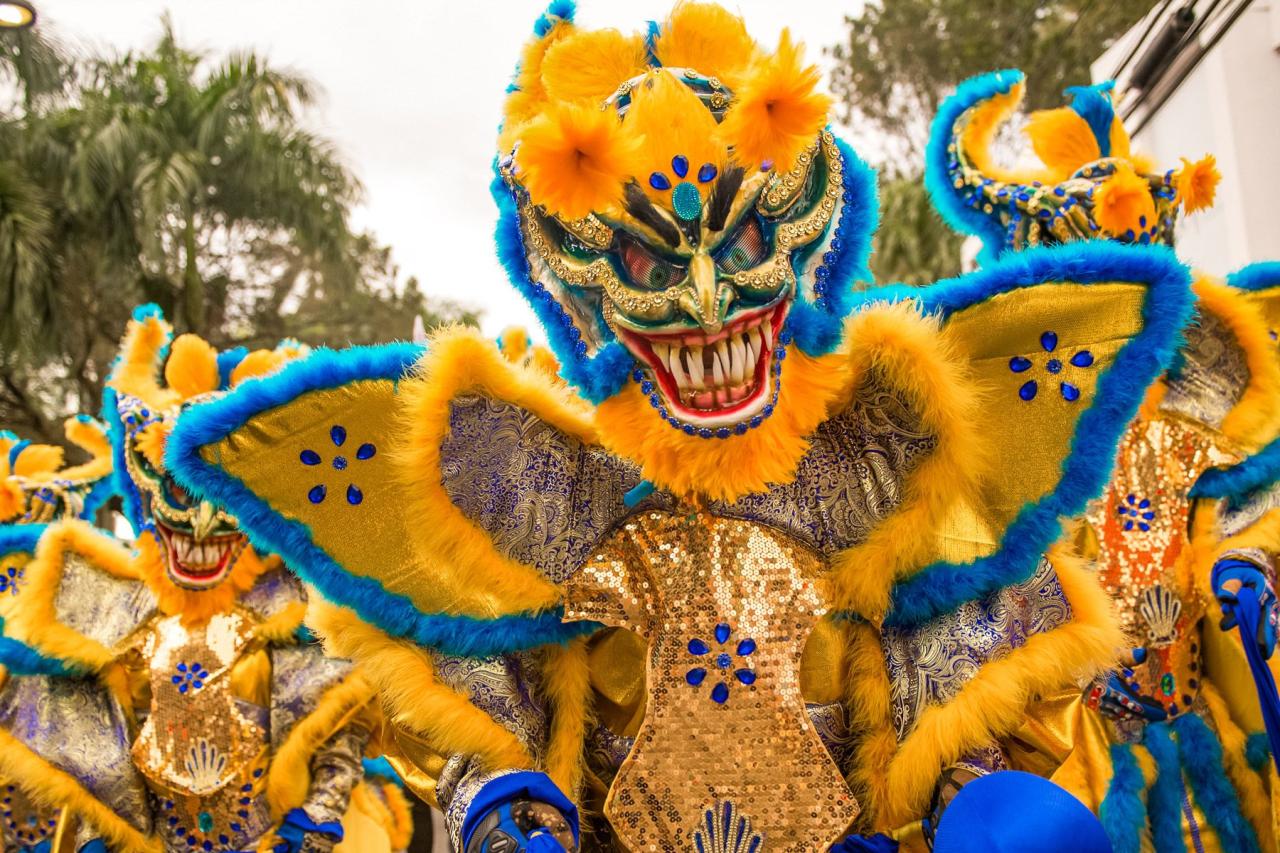
Caribbean Island Festivals Vibrant Culture
Caribbean island festivals offer vibrant cultural displays, showcasing a rich tapestry of traditions and artistic expressions. From lively music and dazzling dances to mouthwatering cuisine and vibrant community spirit, these celebrations are a feast for the senses. They’re more than just events; they’re living embodiments of the islands’ unique histories and cultural heritage.
This exploration delves into the heart of these captivating celebrations, examining the diverse elements that make them so special. We’ll explore the historical significance, artistic displays, culinary traditions, and the crucial role of community participation in shaping these vibrant events.
Introduction to Caribbean Island Festivals

Caribbean island festivals are vibrant celebrations that showcase the rich cultural heritage and diverse traditions of the region. These events are more than just parties; they are powerful expressions of identity, history, and community. From lively parades to captivating music performances, these festivals offer a unique glimpse into the heart of Caribbean life.These festivals are deeply rooted in the islands’ historical experiences, blending indigenous, African, European, and Asian influences.
They provide a platform for preserving and celebrating these cultural elements, ensuring their continuity for future generations. The music, dance, costumes, and food are all interwoven with the stories and struggles of the people who shaped these islands.
General Characteristics of Caribbean Island Festivals
Caribbean island festivals are typically characterized by a blend of vibrant colours, infectious rhythms, and energetic performances. They are communal events, drawing people from all walks of life together. The celebrations often feature music, dance, and food as central elements, reflecting the fusion of culinary traditions. Costumes are usually elaborate and colourful, representing the island’s diverse heritage and often incorporating symbolic elements.
Historical and Cultural Significance
The festivals hold a profound historical and cultural significance for the Caribbean people. They serve as powerful reminders of the struggles and triumphs of the past. Through music, dance, and storytelling, the festivals embody the resilience and creativity of the people. These celebrations are essential for preserving the unique cultural identity of each island. They provide a platform to share history, traditions, and values with younger generations.
Common Themes and Elements
Caribbean island festivals often revolve around themes of community, celebration, and storytelling. The music, whether calypso, reggae, or soca, is a crucial element, often embodying the spirit of the festivities. Elaborate costumes, showcasing local artistry and historical influences, are a striking feature of many events. Food plays a central role, with traditional dishes and new creations highlighting culinary heritage.
Parades, with their vibrant displays and rhythmic movements, often take centre stage, representing the island’s pride.
Diverse Range of Traditions
The Caribbean islands boast a diverse range of traditions, reflected in the wide variety of festivals. Each island has its own unique flavour, incorporating specific elements from its history and culture. These celebrations can range from religious processions to secular street parties, each uniquely expressing the cultural identity of the island. These traditions demonstrate the fusion of various cultural influences, creating a rich tapestry of celebration.
Types of Caribbean Islands and Typical Festivals
| Island Name | Festival Name | Key Cultural Elements | Brief Description |
|---|---|---|---|
| Trinidad and Tobago | Carnival | Calypso music, elaborate costumes, street parades | A vibrant celebration of culture and music, featuring elaborate costumes and street parades. |
| Jamaica | Reggae Sumfest | Reggae music, dance, and performances | A renowned music festival showcasing the island’s rich reggae heritage. |
| Barbados | Crop Over | Calabash making, parades, and music | A festival celebrating the harvest season, featuring parades and various artistic performances. |
| Dominican Republic | Carnival | Music, dancing, and costumes | A vibrant celebration of culture, featuring music, dancing, and colourful costumes. |
Cultural Displays in Festivals
Caribbean island festivals are vibrant celebrations of culture, history, and community. These events showcase the unique artistic expressions and traditions that have evolved over generations, reflecting the diverse heritage of the islands. From the rhythmic beats of music to the powerful movements of dance, and the striking visuals of artistry, these festivals offer a captivating glimpse into the heart of Caribbean culture.The cultural displays at these festivals are more than just entertainment; they are a vital part of the island’s identity.
They provide a platform for artists to showcase their talents, communities to connect, and visitors to experience the richness of Caribbean heritage. These displays often blend traditional forms with contemporary influences, resulting in a dynamic and ever-evolving artistic landscape.
Music Styles Across the Islands
Caribbean music is renowned for its infectious rhythms and soulful melodies. A wide array of musical genres and instruments contribute to the vibrant soundscapes of these celebrations. The diverse musical traditions reflect the region’s history of migration, trade, and cultural exchange.
| Island | Music Genre | Instruments Used | Unique Characteristics |
|---|---|---|---|
| Jamaica | Reggae, Ska, Dancehall | Steel drums, guitars, bass, horns, drums | Reggae’s emphasis on social and political messages, Ska’s upbeat tempo, and Dancehall’s fusion of genres with often socially conscious lyrics. |
| Trinidad and Tobago | Soca, Calypso | Steel drums, pan, guitars, keyboards, percussion | Soca’s high-energy beats and often humorous lyrics, Calypso’s storytelling and satirical elements, and the unique sound of the steel drum. |
| Barbados | Calaloo, Bajan music | Steel drums, guitars, keyboards, drums | Calaloo’s distinctive rhythm and vocals, and Bajan music’s blend of traditional and contemporary influences. |
| Dominican Republic | Merengue, Bachata | Guitars, drums, percussion, accordion | Merengue’s lively rhythms and danceable beat, and Bachata’s romantic and soulful lyrics. |
Dance Performances
Caribbean dance is a powerful expression of emotion and energy. The rhythmic movements often tell stories, evoke feelings, and connect individuals through shared experiences. The variety of styles reflects the diverse cultural influences on the islands. For example, the lively movements of Junkanoo in the Bahamas are a visual representation of the island’s history and pride. The powerful, energetic dances of Carnival in Trinidad and Tobago, filled with costumes and vibrant colors, are another example of this expressive cultural tradition.
Visual Arts
Visual arts play a significant role in Caribbean festivals, with vibrant colors, intricate patterns, and symbolic imagery. Traditional crafts like batik, wood carving, and pottery are often showcased. These artistic expressions provide a tangible connection to the islands’ heritage and craftsmanship. Carnival parades, for instance, feature elaborately decorated floats and costumes, showcasing the artistry of the community.
The vibrant murals painted on the walls of many Caribbean communities are also important visual art displays.
Costumes and Attire
Costumes and attire are integral to showcasing cultural identity at Caribbean festivals. The elaborate costumes, often adorned with vibrant colors and intricate designs, represent specific communities and their unique heritage. For example, the costumes in Carnival celebrations, particularly in Trinidad and Tobago, are a striking display of creativity and cultural pride. The vibrant colors, unique patterns, and symbolic elements within these costumes convey a powerful message of identity and tradition.
Food and Culinary Traditions

Caribbean island festivals are vibrant celebrations of culture, and food plays a central role. From the aroma of sizzling spices to the colourful array of dishes, the culinary experiences are a significant part of the festivities. These feasts aren’t just about satisfying hunger; they’re about sharing stories, strengthening community bonds, and honouring ancestral traditions. The very essence of Caribbean culture is woven into the ingredients and preparation methods.Food is deeply intertwined with Caribbean identity.
Caribbean island festivals are a feast for the senses, showcasing vibrant cultural displays and traditions. But if you’re looking for a different kind of adventure, exploring the ample diversions on Louis Cristal Aegean sailing offers a fantastic alternative. From stunning views to unique onboard experiences, it’s a totally different kind of vibrant display. Ultimately, whether you’re seeking the energy of Caribbean island festivals or the serenity of a sailing cruise, there’s a plethora of incredible experiences waiting for you.
It’s a reflection of the region’s diverse history, encompassing African, European, and indigenous influences. Generations of cooks have refined recipes, passed down through families, creating a rich tapestry of flavours. These dishes, prepared with love and care, aren’t merely meals; they’re expressions of cultural heritage.
Culinary Experiences at Festivals
Festivals offer a spectacular showcase of the region’s diverse culinary traditions. Vendors and local chefs present a wide array of dishes, each unique to its island of origin. The tantalizing smells of jerk chicken, coconut rice, and callaloo stew fill the air, creating an immersive sensory experience. Visitors can sample traditional dishes, like oxtail soup or curried goat, while engaging with the warm hospitality of the local community.
These festivals aren’t just about food; they’re a celebration of Caribbean culture.
Caribbean island festivals are a fantastic display of vibrant culture, showcasing everything from colorful costumes to lively music. With Aruba now accepting JetBlue’s CommonPass health passport, it’s easier than ever to experience these festivities. This makes planning a trip to witness these amazing celebrations even more convenient, ensuring that the vibrant energy of these island events remains accessible to all.
Importance of Food in Caribbean Culture
Food is far more than sustenance in Caribbean culture. It’s a cornerstone of social gatherings, a symbol of hospitality, and a means of expressing cultural heritage. Family meals, potlucks, and communal feasts are commonplace, emphasizing the shared experience of food. From the simplest snacks to elaborate feasts, food acts as a catalyst for connection, forging bonds and fostering community spirit.
Traditional recipes often incorporate local ingredients, further emphasizing the unique character of each island.
Food as a Representation of Cultural Heritage
Each dish tells a story, reflecting the historical influences that shaped the island’s culture. The use of specific ingredients, cooking techniques, and spices are direct reflections of the island’s history and its people. For instance, the use of callaloo, a leafy green, is common in many Caribbean dishes, demonstrating the significant role of indigenous ingredients in shaping the region’s cuisine.
Similarly, the inclusion of African spices and cooking methods, such as jerk seasoning, highlight the profound impact of African heritage.
Different Island Cuisines and Typical Festival Foods, Caribbean island festivals offer vibrant cultural displays
| Island | Dish Name | Ingredients | Culinary Significance |
|---|---|---|---|
| Jamaica | Jerk Chicken | Chicken, Scotch Bonnet peppers, allspice, thyme, ginger, and other spices | A national dish, reflecting the island’s rich history and African influences. The unique jerk seasoning is a symbol of Jamaican culinary identity. |
| Trinidad and Tobago | Doubles | Chapatis, curried chickpeas, spices, and achiote paste | A popular street food, representing the island’s blend of Indian and African influences. |
| Barbados | Cou-Cou | Cornmeal, okra, and other vegetables | A staple dish that embodies Barbadian culinary heritage, highlighting the use of local ingredients. |
| Puerto Rico | Mofongo | Plantains, garlic, oil, and often other ingredients like meat or seafood | A dish deeply rooted in Puerto Rican culture, showcasing the use of plantains as a staple ingredient. |
Role of Food in Community Gatherings and Celebrations
Food is a fundamental part of community gatherings and celebrations. It brings people together, fostering a sense of unity and shared experience. Sharing meals strengthens social bonds, creating an environment of camaraderie and festivity. The festive atmosphere, combined with the delectable food, makes these events memorable and strengthens community ties. Community kitchens and communal dining are vital aspects of these gatherings.
The aroma and flavours of these dishes reflect the spirit of the celebration.
Community Participation and Festivities

Caribbean island festivals are more than just events; they are vibrant expressions of community spirit. These celebrations are deeply rooted in the history and culture of the islands, providing a powerful platform for social interaction and the strengthening of community bonds. The involvement of the entire community, from children to elders, is crucial to the success and spirit of these events.These festivals are not just about entertainment; they are about fostering a sense of belonging and shared identity.
Caribbean island festivals are a feast for the senses, showcasing vibrant traditions and colourful costumes. However, recent news about the Air Jamaica CEO’s resignation, sparking protests, highlights a different kind of cultural display – one of discontent and change within the travel industry. air jamaica ceo resignation prompts protest Regardless, the vibrant cultural displays of Caribbean island festivals still offer a beautiful glimpse into the rich history and heritage of these islands.
They offer a space for people of all ages and backgrounds to come together, celebrate their heritage, and reinforce the social fabric of their communities. The energy and enthusiasm generated during these festivities create a powerful feeling of unity and shared purpose.
Community Involvement in Festivals
Caribbean island festivals are a spectacular display of communal effort. Participation spans across all age groups and social strata, reflecting the importance of these events for social cohesion. The diverse contributions of the community members highlight the interconnectedness and shared responsibility that underpin the spirit of these celebrations.
| Type of Involvement | Description | Example Activity | Significance |
|---|---|---|---|
| Music and Dance | Communities often come together to perform music, dance, and drumming. | Participation in parades, street dances, and elaborate costume performances. | These displays demonstrate the community’s creativity and artistic expression, showcasing a collective cultural heritage. |
| Food Preparation and Sales | Food stalls and vendors are often run by community members, showcasing local cuisine. | Selling traditional dishes and beverages, like jerk chicken, callaloo soup, or coconut water. | Food preparation and sales contribute to the festival’s atmosphere and provide economic opportunities for community members. |
| Craft Production and Sales | Local artisans create and sell unique crafts, adding to the festival’s aesthetic richness. | Selling handcrafted jewelry, pottery, paintings, and other unique souvenirs. | This aspect of the festival highlights the rich artistic talent within the community and fosters economic growth. |
| Decorations and Set Design | Communities contribute to the visual appeal of the festival by creating elaborate decorations. | Constructing floats, banners, and decorations for parades or venues. | The community’s collective effort in beautifying the festival space enhances the overall experience and demonstrates the spirit of collaboration. |
Role of Families and Children
The involvement of families and children in Caribbean island festivals is a significant aspect of community cohesion. Children are often actively engaged in the celebrations, learning about their culture and heritage through participation. Families come together to celebrate, strengthening their bonds and creating lasting memories. The inclusion of children in festival activities nurtures a sense of pride and belonging in the community.Children participate in a variety of ways, from helping with decorations to performing in dances and drumming circles.
This active involvement creates lasting memories and fosters a sense of belonging within the community. The festival’s environment provides a wonderful opportunity for children to connect with their cultural roots and embrace the spirit of celebration. Families often collaborate on costumes, crafts, and food preparations, strengthening their bonds and creating lasting memories.
Visual Representation of Festivals
Caribbean island festivals are more than just events; they are vibrant expressions of culture, history, and community. The visual elements of these celebrations, from the dazzling costumes to the infectious rhythms, are crucial in capturing the essence of the festivities and conveying their unique spirit to onlookers. These displays are not just aesthetically pleasing; they are powerful symbols, imbued with meaning and tradition.
Costumes and Attire
The colorful costumes worn during Caribbean island festivals are a testament to the region’s rich tapestry of creativity. Each island, and even individual communities, often have distinct styles, colors, and patterns. These garments are more than just clothing; they are works of art, carefully crafted with intricate details and symbolic elements. From feathered headdresses to elaborate masks, the costumes tell stories of mythology, history, and social values.
“The vibrant colors of the costumes, ranging from fiery reds and oranges to deep blues and greens, are a feast for the eyes, creating a truly spectacular display.”
“Intricate patterns and designs, often inspired by nature or local folklore, adorn the garments, adding depth and meaning to the visual representation.”
“Elaborate headdresses, masks, and accessories further enhance the costumes, amplifying the theatrical and symbolic nature of the festival.”
Caribbean island festivals are a feast for the senses, showcasing vibrant traditions and colorful costumes. While those islands are known for their lively celebrations, did you know that the Australian capital, Canberra , is a city for all seasons? From bustling markets to stunning beaches, there’s always something exciting to discover, mirroring the diverse and energetic spirit of Caribbean island festivals.
Musical Performances
The music of Caribbean island festivals is a driving force behind the celebrations. The infectious rhythms and energetic beats are essential elements of the festivities, creating an atmosphere of joy and unity. From steel drums to calypso music, the soundscape of these events is uniquely captivating. Often, musical performances are integrated into the larger cultural displays, highlighting the importance of music in Caribbean society.
“The powerful beats of the steel drums create a vibrant soundscape that fills the air, drawing in participants and spectators alike.”
“The rhythmic movements of dancers complement the music, creating a dynamic and captivating performance that is both visually stunning and energetically infectious.”
“The rhythmic clapping and singing of the crowds further amplify the festive atmosphere, creating a powerful wave of shared joy and excitement.”
Food Stalls and Culinary Traditions
Food stalls are a critical component of Caribbean island festivals. They showcase the region’s diverse culinary traditions, providing a sensory experience that is as vibrant as the rest of the festivities. From mouth-watering curries to spicy stews, the food stalls offer a chance to savor the flavors of the islands. The variety of food available highlights the cultural exchange that has shaped the region’s cuisine.
“Colorful displays of freshly prepared food, from grilled meats to tropical fruits, create an enticing and appetizing atmosphere.”
“The aroma of spices and herbs, wafting through the air, further enhances the experience, drawing people into the culinary offerings.”
“The different styles of food preparation, reflecting diverse cultural influences, contribute to the festival’s unique culinary landscape.”
Caribbean island festivals are a feast for the senses, showcasing vibrant costumes, music, and dance. However, news like the recent Aker halting delivery of building materials for an NCL ship ( aker halts delivery of building materials for ncl ship ) highlights how global events can sometimes impact even the most joyful celebrations. Luckily, the vibrant spirit of these islands’ festivities remains strong, promising spectacular cultural displays throughout the year.
Overall Atmosphere
The atmosphere of Caribbean island festivals is electric and infectious. The combination of vibrant colors, infectious music, and the joyous energy of the crowds creates an unforgettable experience. The overall feeling is one of community, celebration, and shared joy. People from all walks of life come together to participate in the festivities, creating a truly inclusive and welcoming environment.
“The atmosphere is charged with a palpable sense of excitement and community spirit, creating an unforgettable experience for all.”
“The infectious energy of the festival is contagious, drawing people into the celebrations and creating a vibrant, dynamic atmosphere.”
“The sense of unity and shared joy is evident in the interactions between participants and spectators, creating a truly inclusive and celebratory atmosphere.”
“The overall visual display, combining vibrant costumes, energetic music, and delicious food, paints a picture of vibrant culture and community spirit.”
Last Point: Caribbean Island Festivals Offer Vibrant Cultural Displays
In conclusion, Caribbean island festivals are a powerful expression of cultural identity, community spirit, and artistic creativity. These events are more than just parties; they’re powerful reminders of the rich history and traditions of the islands. The vibrant energy, artistic displays, and communal spirit of these festivals create a truly unforgettable experience.
FAQ
What are some common themes found in these festivals?
Common themes often include celebration of heritage, community bonding, and showcasing local talent through music, dance, and visual arts. Many also highlight agricultural harvests and seasonal changes.
How do festivals contribute to social cohesion?
Festivals provide a platform for community members to come together, fostering a sense of belonging and shared identity. They bring people of different backgrounds together, strengthening social bonds.
What are some examples of visual art found in Caribbean festivals?
Visual arts can include elaborate costumes, vibrant decorations, and intricate masks. The use of color, patterns, and symbolism often tells a story related to the festival’s themes.
Are there specific instruments commonly used in Caribbean music?
Common instruments include steel drums, congas, guitars, and various percussion instruments. The specific instruments used can vary based on the island and the type of music.

